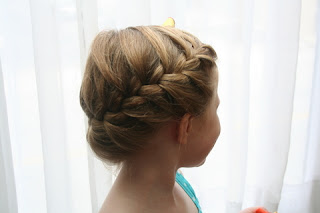and Chapter 2 in
So, what is a sloper? A sloper is a basic pattern template that you can manipulate to create most any pattern. The books come with half-size slopers in the back, which are nice to work with when you are learning pattern manipulations. And, dresses made with the half-size slopers are so cute -- check out some examples that are displayed in the classroom from previous years.
One note about the slopers -- they don't include a seam allowance. My mom tried a computer-aided pattern design program to make patterns to sew for me long distance about umpteen years ago. After a full afternoon making measurements with all sorts of magic marker lines drawn on my body, the muslin made from that pattern fit me like a glove. As in skin tight. I wonder if it made a "sloper" pattern without seam allowances included.
We started by learning to move the darts in the front bodice sloper. Key points:
1. The bust point marked on the pattern is the fixed point on the pattern. Everything else revolves around it (literally). Stick a pin in it.
2. Start where you want to end -- when you open a new dart, you start tracing around the sloper from the point where the dart will open. This is also where you stop tracing.
3. New darts created have to have the same total angle as the closed dart. In physics, this would be a conservation law: Total dart angles are conserved.
At least, total dart angle is conserved when you split one dart into two. It's really a bit more arbitrary than that, because you actually want to fit a person when you're done, and most persons don't fit exact mathematical models. :)
Our first exercise: move a bust fitting dart from the side seam to a dart in the shoulder seam. Starting from the point on the should seam where you want the dart, trace around the sloper until you come to the side dart, then rotate the sloper (about the pin stuck in the bust point) until the side dart is exactly closed. Continue tracing around the sloper until you reach the point on the shoulder seam where you started. The two legs of the new dart are drawn to a point within the bust circle, which is a circle centered at the bust point with a diameter of about three inches. Here are pictures of the original sloper, and new new one with the dart moved.
And that was just the first example in the book, using the "rotation method" to move the dart. Only fifty-nine more pattern manipulations to go. (No, I really haven't counted them.)
Next assignment is to make twenty more dress designs, playing with variations on two or three of the designs from this week. My challenge is to add more decorative darts, move away from the basic fitting darts, and to include more embellishment and design elements. This is an apparel design course, after all, so I need to come up with something more exotic than the usual princess seams.































